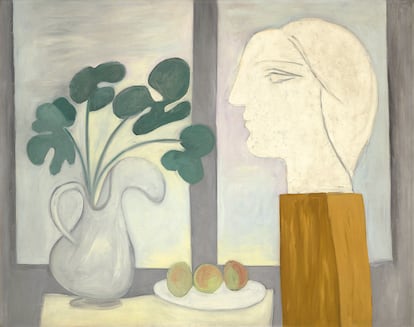Feminism deflates Picasso prices
50 years after his death, the genius’s sales are suffering because of stricter social mores and a dearth of great art on the market

The genius, the monster, the vampire. “He needed blood to sign each of his paintings: my father’s blood, my brother’s, my mother’s, my grandmother’s, and mine. He needed the blood of those who loved him.” Marina Picasso wrote this in her 2001 autobiography, Picasso, My Grandfather. On the 50th anniversary of his death (April 8, 1973), the weight of the 21st century and its feminist mores have fallen heavily on the painter. When he wasn’t working on his art, Picasso was difficult, dark, manipulative, charismatic, narcissistic and tyrannical with women. Many have asked whether the dissonance between the person and the talent affected the value and price of his work. The answer is a resounding no. A Picasso was always a Picasso during world wars, the Great Depression of 1929 and the 2008 financial crisis. His pieces were like cash in hand. But now, prices for Picassos on the specialized art website Mutualart.com are looking a little deflated, which has never happened before in the history of the artist from Málaga (Spain).
Auction prices are best viewed as trends, not Biblical commandments. So far this year, over $97 million (€89 million) in artwork has been sold, up from the losing streak of the pandemic years ($511 million in 2022; $667 million in 2021; and $243 million in 2020). In 2023, 1,798 lots have been offered, but only 994 (55.2%) were sold at auction. In contrast, 5,522 pieces were offered in 2021 and 4,001 found buyers. Average auction prices today also reveal a certain softness in the market. In 2022, the average price was $4,401; in 2023, it dropped to $3,776. Average prices are important indicators because they reveal trends that are not skewed by a single very expensive or inexpensive piece. This year, just one large Picasso canvas has come onto the market. On May 11, Christie’s will auction Nature morte à la fenêtre, an oil on canvas painted by Picasso in 1932, a year before his 1933 breakthrough. The auction house has not set a starting price, but believes it will go for around $40 million. But even if it brings in that amount, it’s much less than Femme nue couchée (1932) another Picasso oil sold by Sotheby’s for $67.5 million in 2022, or Tête de femme (Fernande), a Picasso bust sculpted in 1909 that Christie’s sold just a few days earlier for $48.5 million.

Whatever happens with Nature morte à la fenêtre, the sale price will not reflect the broader market value of Picasso’s body of work. A great piece usually fetches a great price. Moreover, art collectors usually don’t offer their best pieces in tough economies. In February, a huge oil on canvas (76 x 51 1/4 in. or 194.5 x 130.1 cm.) painted by Picasso in 1956 titled Femme dans un rocking-chair (Jacqueline) sold for £16.9 million (€19.5 million or $21.3 million). This was in the middle of the £15-20 million range set by Christie’s, which denies any “weakness” in the Picasso market. The Pace Gallery in New York City (declining any comment on his personal life) will open an exhibit in November of 14 Picasso sketchbooks, created between 1900-1959. The gallery emphatically said the sketchbooks “are not for sale.”
The numbers clearly show that Picasso prices are suffering. Perhaps it’s because Picasso was known for saying things like, “Women are machines made for suffering… There are only two types: goddesses and doormats.” As in any myth, excess and injustice often coexist with genius. You have to ask why.
Manolo Borja-Villel, the former director of Madrid’s Museo Reina Sofia, Spain’s national museum of 20th-century art, gave us his view. “I don’t think Picasso’s stature will suffer in the medium or long term. Attacking the man is easy. The current anti-patriarchal narrative has somewhat eroded the patriarchal Picasso’s reputation. He wasn’t the only one who behaved like that, but the aura of his genius took him further than others,” he said. “It begs the question of why such attitudes were normal at the time and even indicative of talent.” This theme underlies the Juan de Pareja (Velázquez’s longtime slave, whom he freed on his second trip to Rome) exhibit at the Metropolitan Museum of Art in New York (on display until June 16). “Violent, colonial, enslaving and unequal social structures have a way of bringing out artistic beauty and virtue,” said Borja-Villel.
This summer, the Brooklyn Museum (New York) will open an exhibit called “It’s Pablo-matic.” Curated by Picasso critic Hannah Gadsby, the exhibit examines the artist’s complicated legacy through a contemporary, feminist lens. Meanwhile, designer Paul Smith is preparing an exhibition at the Musée Picasso in Paris to appeal to a younger crowd. “The life and behavior of a creator should not prevent a critical appreciation in strictly artistic terms. But ethical strictures are more rigid than ever these days,” said art curator Bartomeu Marí.
A last word on prices. According to Mutualart.com, the average price of a Picasso in 2023 is $3,776. At the peak of the pandemic in 2020, it was $5,252. The minotaur has been wounded.
Sign up for our weekly newsletter to get more English-language news coverage from EL PAÍS USA Edition
Tu suscripción se está usando en otro dispositivo
¿Quieres añadir otro usuario a tu suscripción?
Si continúas leyendo en este dispositivo, no se podrá leer en el otro.
FlechaTu suscripción se está usando en otro dispositivo y solo puedes acceder a EL PAÍS desde un dispositivo a la vez.
Si quieres compartir tu cuenta, cambia tu suscripción a la modalidad Premium, así podrás añadir otro usuario. Cada uno accederá con su propia cuenta de email, lo que os permitirá personalizar vuestra experiencia en EL PAÍS.
¿Tienes una suscripción de empresa? Accede aquí para contratar más cuentas.
En el caso de no saber quién está usando tu cuenta, te recomendamos cambiar tu contraseña aquí.
Si decides continuar compartiendo tu cuenta, este mensaje se mostrará en tu dispositivo y en el de la otra persona que está usando tu cuenta de forma indefinida, afectando a tu experiencia de lectura. Puedes consultar aquí los términos y condiciones de la suscripción digital.
More information
Archived In
Últimas noticias
Alain Aspect, Nobel laureate in physics: ‘Einstein was so smart that he would have had to recognize quantum entanglement’
Imelda Castro, the woman who wants to rule the cartel battleground of Sinaloa
The new victims of the Republican war on Obamacare: Millions hit by soaring health insurance premiums
A country divided on migrant rights: Some US states expand protections while others restrict them
Most viewed
- David King, chemist: ‘There are scientists studying how to cool the planet; nobody should stop these experiments from happening’
- Reinhard Genzel, Nobel laureate in physics: ‘One-minute videos will never give you the truth’
- Oona Chaplin: ‘I told James Cameron that I was living in a treehouse and starting a permaculture project with a friend’
- Sinaloa Cartel war is taking its toll on Los Chapitos
- Mexico completes its trade shift with the entry into force of tariffs on China and countries without trade agreements











































